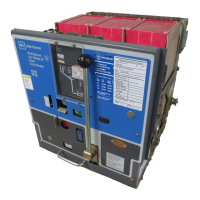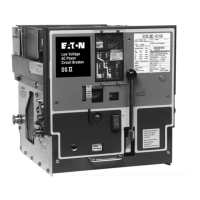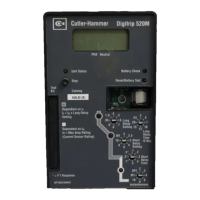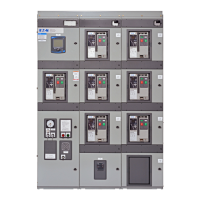Page 36
Manually operated breakers may also be furnished with
this feature if they are equipped with optional electrical
spring release devices.
5.1.8.4 Closed Breaker Interlock
Figure
31
shows how operation
of
the spring release
latch is prevented when the breaker already is
in
the
closed position. The Close Bar is connected to the spring
release latch by a link and bell crank. The link is pivoted
on the lower end
of
the close bar cam by a pin as shown.
As the Close Bar is pushed, the pin and latch link will
move to the right, along with the lower end
of
the cam.
The lower end
of
the link is facing a knife edge pivot on
the vertical arm
of
the bell crank. The upper end
of
the
link is facing the Open-Close Indicator Pin. This pin is at
the left end
of
its slot
in
the mechanism side frame with
the breaker open and at the right end with the breaker
closed.
As
the Close Bar is pushed, the link therefore has
two possible end pivots.
If
the breaker is open the upper
end
of
the link will swing to the right until it touches the
indicator pin. The lower end
of
the link will then swing to
the right and push the vertical arm
of
the bell crank to the
right. The horizontal arm
of
the bell crank moves down-
ward and presses directly on the spring release latch,
allowing the breaker to close.
If
the breaker already is closed and the Close Bar is
pushed, the upper end
of
the spring release latch link will
swing free to the right because the indicator pin is not
there to stop
it.
Consequently, no force is applied to the
vertical arm
of
the bell crank, and nothing else happens.
5.1.8.5 Padlocking Provision
Figure
32
shows the essential parts
of
the padlock inter-
lock. The breaker is padlocked
in
the trip-free condition
in
which the breaker cannot be closed and the breaker can-
not be moved with the levering device. This figure shows
the relation
of
parts for padlocking
in
the trip-free, shutter
up condition. There are three major parts involved, which
are interleaved and assembled
on
the left hand side
of
the levering device assembly:
1.
The Shutter
2.
The Trip Plate
3.
The Padlock Interlock Lever
The Padlock Interlock lever is located between the Trip
Plate and the Padlock Plate, and is pivoted on a fixed
center toward the rear
of
the breaker. The front part
of
this lever has a sloping slot into which a projection from
the trip plate extends. Horizontal movement
of
the trip
plate by cam action
of
the projection against the walls
of
1.8. 33-790-11
the slot, causes the front
of
the interlock lever to move up
or
down. The interlock lever is pushed upward
by
a
spring. This lever also has a short pin extending outward
normally into a curved notch
in
the bottom edge
of
the
padlock plate.
1. Padlock Plate Notch
2. Padlock Plate
3. Trip Plate
4.
Front
Panel
5.
Shutter
.
6.
L.awring
Davica Worm
Shaft
7. Projection
on
Shutter
8.
Bent
Tab
on
Padlock Plata
9.
Projection
on
Trip Plate
10. Padlock Interlock Lever
11. Pin
on
Padlock I ntarlock Lewr
12. Trip
Shalt
Fig. 32 Padlock Device - Locked Trip Free and Shutter
Raised
To padlock the breaker, with shutter closed, push the trip
plate
in.
Pull the padlock plate forward. This exposes the
padlock slot
in
the padlock plate. Insert the padlock and
lock.
Movement
of
the trip plate pushes the front end
of
the
padlock interlock lever down, moving its pin downward
and out
of
the notch
in
the padlock plate. Forward move-
ment
of
the padlock plate and backward movement
of
the
trip plate places the pin
in
the padlock interlock lever
behind the notch
in
the padlock plate. With the padlock
plate held forward, the padlock interlock lever cannot
move. The projection from the trip plate is consequently
held
in
the slot
in
the padlock interlock lever, so the
breaker remains locked
in
the trip-free condition until the
padlock is removed and the members are returned to
their normal positions by their return springs. While so
locked, the shutter is prevented from downward travel by
a horizontal projection striking a bent-over tab
on
the
padlock plate.
Effective October 1998
Courtesy of NationalSwitchgear.com

